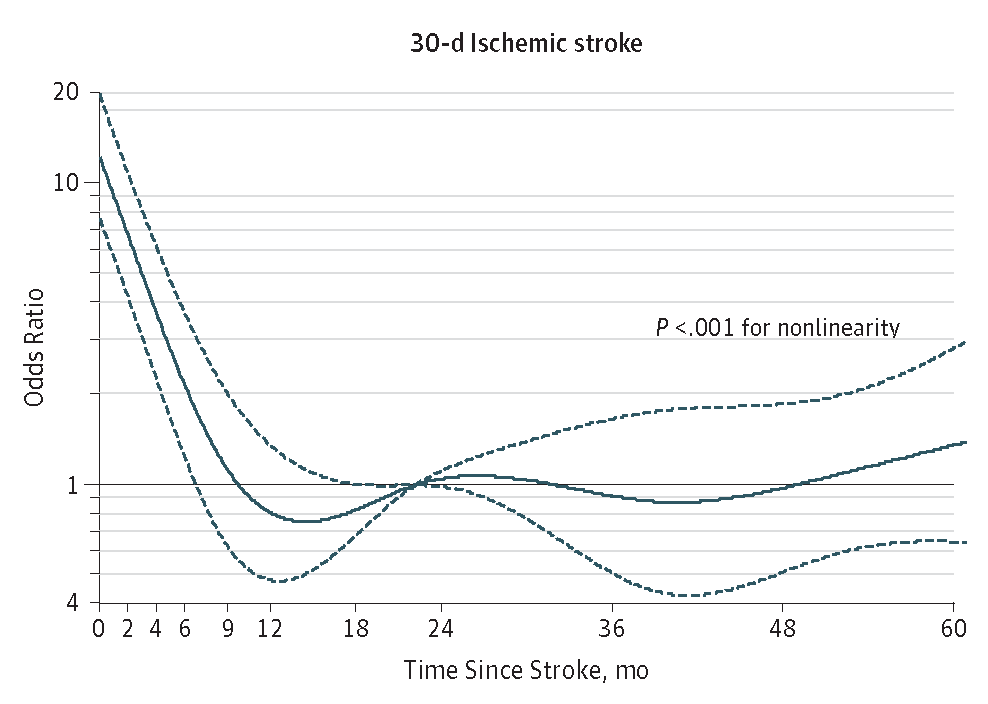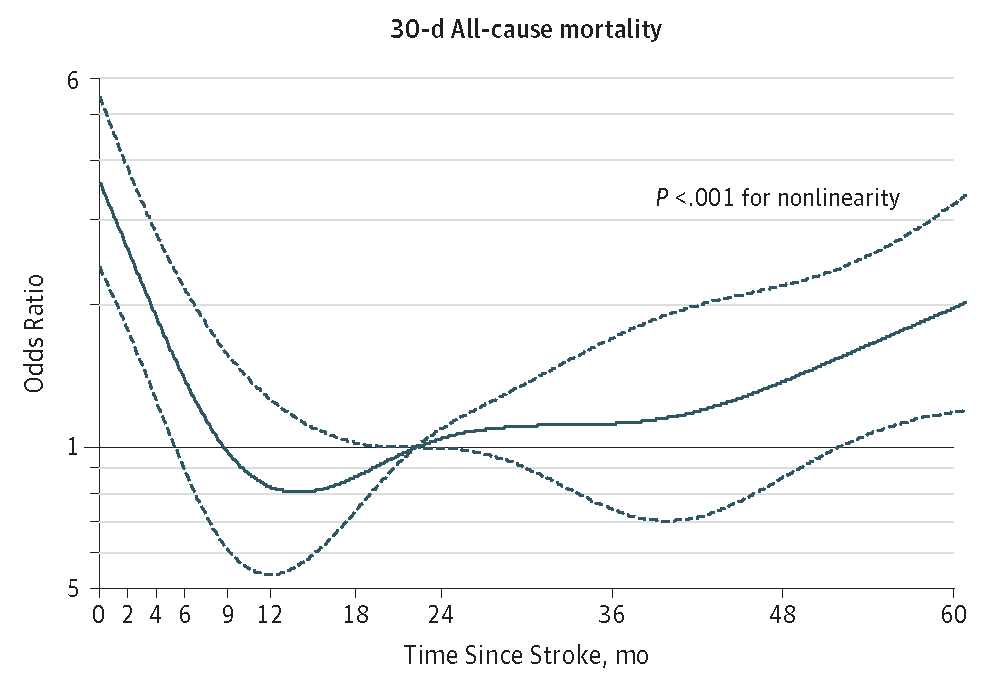Search POM Topics
-
Crisis
-
General
-
Perioperative Medication Management
-
Investigations
-
Calculators
-
Cardiology
-
Complications
-
Day Surgery
-
Endocine
-
Haematology
-
Neurology
-
Paediatrics
-
Pain
-
Respiratory
-
Useful Links
Stroke
Assessing Perioperative Stroke Risk
Baseline Risk
Previous Stroke
Risk of Perioperative Stroke AS Compared to Patients with NO History of Stroke
|
Risk Factors for Perioperative Stroke |
|
|
Time Since Previous Stroke |
30 Day OR for Ischaemic Stroke |
|
< 3 Months Prior |
67.6 |
|
3 - < 6 Months Prior |
24.02 |
|
6 - < 12 Months Prior |
10.39 |
|
≥ 12 Months Prior |
8.17 |
|
Any History of Stroke |
16.24 |
Recency of Previous Stroke
Recency of the previous stroke compounds this risk substantially, with patients undergoing surgery within 3 months of a stroke suffering ~12% risk of perioperative stroke in the subsequent surgery.
These patients are also at substantially increased risk of major adverse cardiac events (MACE) and death..
30 Day Perioperative Risk of Stroke and MI According to Time Elapsed Between Stroke and Surgery
A Danish cohort study of ~400,000 patients concluded that the period of increased risk extends to around 9 months following the initial stroke.
Risk beyond that period remains elevated compared to patients without a history of stroke, but does not appear to decline further over time.
Association Between Time Elapsed Since Stroke and 30 Day Risk of Ischaemic Stroke, Major Adverse Cardiac Events (MACE) and Mortality.
Odds Ratios relative to Reference of Study Median Duration between Stroke and Surgery (665 Days)



Patient Risk Factors for Perioperative Stroke
Perioperative Stroke shares many of the same risk factors as perioperative MACE.
The following patient risk factors should be considered when weighing individual patent risk.
|
Risk Factors for Perioperative Stroke |
|
|
Risk Factor |
30 Day OR for Ischaemic Stroke |
|
Emergency Surgery |
~ 8 |
|
Postoperative Hypotension |
~ 5 |
|
MI Within 6 Months |
3.8 |
|
Renal Failure |
2.98 |
|
Patent Foramen Ovale |
2.6 |
|
History of Hypertension |
2.0 |
|
Atrial Fibrilation |
1.95 |
|
COPD |
1.8 |
|
Valvular Heart Disease |
1.54 |
|
Smoking |
1.5 |
Surgical Risk Factors for Perioperative Stroke
Risk of perioperative stroke has been shown to vary by type of surgery5. The below graph compared Odds Risk for perioperative stroke as compared to a reference of patients undergoing general surgery procedures.
Relative Risk of Perioperative Stroke in Different Surgical Procedures
Perioperative Stroke Risk Calculators
High cardiovascular risk on the MICA score indicates an increased risk of perioperative stroke.
Other Things to Consider in at Risk Patients
Bridge patients with AF and a high CHAD2SVASC risk, Consider bridging moderate risk patients
Continue beta-blockers and statins in patients already on them
Regional anaesthesia may have some small benefit
propofol and volatile do not seem to a have significantly different risk
maintain baseline MAP
maintain normocapnoea (avoid hypocapnoea which may increase cerebrovascular resistance)
maintain BGL 7.2-10.0mmol
Intraoperative Hypotension (time spent with MAP more than 30% below baseline) is associated with risk of post-operative stroke8
References
- Aspirin in Patients Undergoing Noncardiac Surgery - POISE-2 - NEJM 2014
- Incidence, Predictors, and Outcomes of Perioperative Stroke in Noncarotid Major Vascular Surgery - Anesth Analg 2013
- Time Elapsed After Ischemic Stroke and Risk of Adverse Cardiovascular Events and Mortality Following Elective Non-Cardiac Surgery - JAMA 2014
- Perioperative Care of Patients at High Risk of Stroke During or After Non-Cardac, Non-Neurological Surgery - 2020 SNACC Guidelines - J Neurosurg Anaesthesiol 2020
- Perioperative Major Adverse Cardiovascular and Cerebrovascular Events Associated With Noncardiac Surgery - GUPTA - CVA - JAMA 2017
- Perioperative stroke and Associated Mortality after Noncardiac, Nonneurologic Surgery - Anesthesiology 2011
- Cardiovascular Risk Scores to Predict Perioperative Stroke in Noncardiac Surgery - Stroke 2019
- Intraoperative Hypotension and Perioperative Ischaemic Stroke after General Surgery - Anesthesiology 2012
- Perioperative Stroke After Non-Cardiac, Non-Neurological Surgery - BJA Education 2020
- Perioperative Care of Patients at High Risk for Stroke During or After Non-Cardiac Surgery - J Neurosurg Anesthesiol 2014
- Cardiovascular Risk Scores to Predict Perioperative Stroke in Noncardiac Surgery - Stroke 2019
- Perioperative Major Adverse Cardiovascular and Cerebrovascular Events Associated With Noncardiac Surgery - GUPTA - CVA - JAMA 2017
- Perioperative stroke and Associated Mortality after Noncardiac, Nonneurologic Surgery - Anesthesiology 2011
- Development and Validation of a Prediction Model for Stroke Cardiac and Mortality Risk After Non-Cardiac Surgery - JAMA 2021